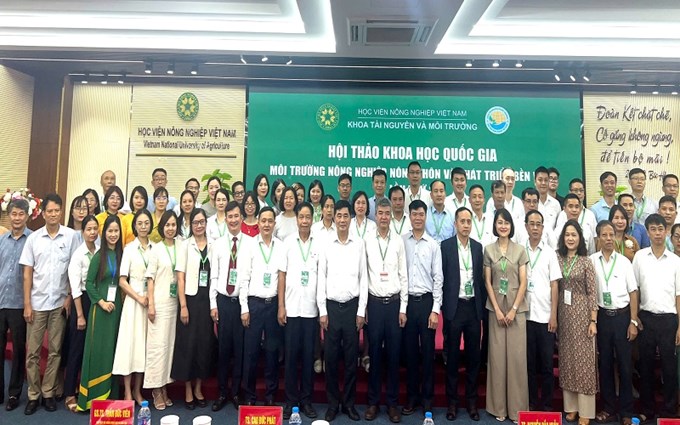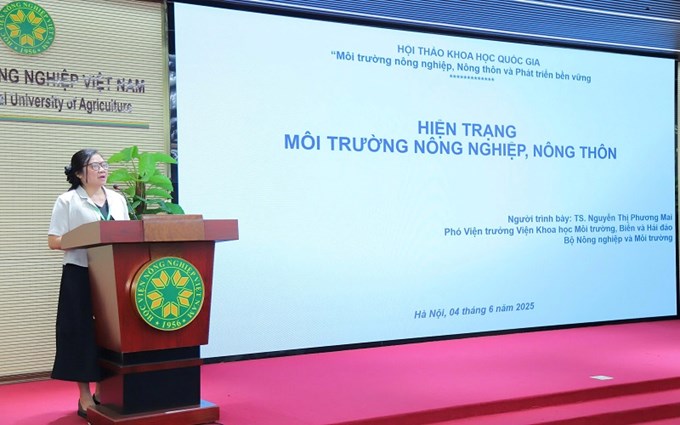On June 4, 2025, at the Nguyet Que Hall, Vietnam National University of Agriculture (VNUA) held the 2nd National Scientific Conference on Agricultural and Rural Environment and Sustainable Development. Prof. Dr. Pham Van Cuong, VNUA’s Vice President, was the chairman of the conference.

The delegates take a photo at the conference.
Attending the conference were Dr. Cao Duc Phat, former Minister of Agriculture and Rural Development and Vice Chairman of the Council of Vietnam National University of Agriculture (VNUA); Dr. Nguyen Dac Nhan, Deputy Director of the Department of Land Management, Ministry of Agriculture and Environment; Dr. Nguyen Dac Hau, Deputy Head of the Party Inspection Committee, Ministry of Ethnic and Religious Affairs; Prof. Dr. Nguyen Xuan Hai, Deputy Director of the Department of Environment; Dr. Nguyen Thi Phuong Mai, Deputy Director of the Institute of Environmental Science, Marine and Islands (Ministry of Agriculture and Environment); and Dr. Duong Thanh Hai, Vice Editor-in-Chief of the Journal of Agriculture and Environment. There were also experts and scientists from various departments of VNUA, different universities, research institutes, and leaders from several provincial Departments of Agriculture and Environment in northern Vietnam participating in the conference.
This second national conference focused on three key themes, (i) Technologies and ecological solutions in agriculture in the digital era; (ii) Agricultural development in association with environmental protection; and (iii) Environmental protection planning policies in the digital age.
The conference also served as a platform for scientists, experts, businesses, and policymakers to connect and share insights, joining efforts to build a green, smart, and environmentally friendly agricultural sector that would ensure sustainable development.

Prof. Dr. Pham Van Cuong, VNUA’s Vice President, delivers a speech at the conference.
In his opening remarks at the conference, Prof. Dr. Pham Van Cuong emphasized that this was a highly significant event, contributing to the collective voice of scientists, experts, and policymakers on environmental protection in agriculture and rural areas, particularly as the Party and the Government were advancing the new rural development program toward ecological
“The conference is held in the context of the recent merger of two ministries, the Ministry of Agriculture and Rural Development and the Ministry of Natural Resources and Environment, now renamed the Ministry of Agriculture and Environment. This further underscores the crucial role of environmental protection in the sustainable development of Vietnam’s agriculture and rural regions,” Prof. Dr. Pham Van Cuong shared.
He added, “The conference serves as a platform for scientists, managers, entrepreneurs, farmers, and a large number of students to exchange knowledge, experiences, and practical models of advanced modern agriculture oriented toward green and sustainable development.”
The conference was divided into two sessions: a Plenary Session (in the morning) chaired by Assoc. Prof. Dr. Vo Huu Cong and Dr. Dinh Thi Hai Van, and a Specialized Session (in the afternoon) consisting of three sub-panels: (i) Sub-panel 1: Technologies and Ecological Solutions for Agriculture in the Digital Era, chaired by Dr. Trinh Quang Huy and Dr. Trinh Phuong Ngoc; (ii) Sub-panel 2: Agricultural Development in Association with Environmental Protection, chaired by Prof. Dr. Nguyen Vo Chau Ngan and Dr. Nguyen Thi Phuong Mai; (iii) Sub-panel 3: Environmental Protection Planning Policies in the Digital Era, chaired by Assoc. Prof. Dr. Ngo The An and Dr. Dinh Hong Duyen.
Many Challenges and Obstacles in Environmental Management in Rural Areas

Dr. Nguyen Thi Phuong Mai delivers a speech at the conference.
According to Dr. Nguyen Thi Phuong Mai, Deputy Director of the Institute of Environmental Science, Marine and Island Studies, rural domestic waste management still faced many shortcomings. The rate of direct landfill disposal of household solid waste remained high. Waste treatment technologies in many localities did not meet the standards; many waste treatment facilities were small-scale with low processing capacities, making it difficult to transition to modern technologies. There was a lack of designated locations and technical infrastructure for the collection, sorting, temporary storage, and transportation of waste that met aesthetic and environmental hygiene standards. In rural areas, there was no proper system for collecting and treating wastewater; domestic and production wastewater was often discharged directly into canals, ponds, and lakes, leading to environmental pollution. Agricultural waste management, particularly of pesticide packaging, remained a major challenge. The collection and treatment of solid waste from agricultural activities, especially packaging, bottles, and containers of pesticides, were still very limited. The current methods for handling pesticide packaging were generally unsafe and unhygienic. Environmental pollution from craft villages had not been thoroughly addressed. In many rural areas, there were still highly polluting industries (such as plastic and metal recycling, livestock farming, and paper production) that did not comply with environmental protection regulations. The responsibility of local authorities in managing the environmental impact of craft villages was still insufficient. Budget and resources for inspection and enforcement activities were inadequate, making these areas persistent environmental hotspots.
Sharing the same perspective and highlighting the consequences of rural environmental pollution, Mr. Nguyen Thanh Lam and Mr. Vo Huu Cong, Faculty of Natural Resources and Environment, VNUA, emphasized that unplanned and excessive agricultural production by local residents led to severe market crises for agricultural products. The “herd mentality” had previously occurred with crops such as watermelon, white radish, dragon fruit, and pork. As a result, rural landscapes had been left desolate, with unharvested produce rotting in the fields and abandoned livestock barns, causing serious sanitation and environmental issues. The significant drop in production efficiency had directly affected the livelihoods of local communities. Although the government and social organizations had launched “rescue programs” to help farmers deal with unsold produce, the environmental consequences, such as ecological degradation and long-term impacts on cultivated land, would persist for many years to come.
"Environmental pollution and food safety in rural areas are reaching alarming levels, with nitrate (NO₃⁻) residues in vegetables found to exceed standard limits multiple times. Farmers are having to use low-quality irrigation water from the Nhue, Day, and Cau rivers for agricultural production. Residents in four southern districts of Hanoi have even had to pump water through intermediary bio-lake systems before using it for irrigation. The overuse of chemical fertilizers, pesticides, and herbicides has been widely reported in the media and documented in numerous research studies. Additionally, the practice of burning rice straw after harvest remains common,” Mr. Nguyen Thanh Lam and Mr. Vo Huu Công noted.
Also at the conference, Dr. Pham Thi Dao, Deputy Director of the Hai Dương Department of Agriculture and Environment, presented a report on the practical management of agricultural and rural environmental issues in the locality. According to Dr. Pham Thi Dao, the management of agricultural and rural environmental issues in the locality faced numerous difficulties and challenges. The volume of waste was increasing, while local residents had not developed the habit of sorting waste at the source. Meanwhile, waste collection and treatment infrastructure remained incomplete and inconsistent, failing to meet growing demands. As a result, managing and treating waste effectively was a major challenge. It required the development of comprehensive and modern waste treatment systems, as well as the promotion of source separation practices, ensuring synchronization and thorough implementation across the system.
In addition, investing in rural transportation infrastructure and developing green, clean, and beautiful villages and residential areas was a crucial factor that required the active involvement of all levels of government and sectors. “There should be a strong focus on developing high-tech agriculture, organic farming, and high-quality services. This requires significant investment in infrastructure and new technologies. To achieve the goal of developing a sustainable, green, and clean agricultural and rural sector, the active participation of all social classes and political–social organizations is essential. Raising public awareness and fostering a sense of environmental protection among the population is of utmost importance. In the coming period, Hai Duong Province needs to intensify administrative reform and innovate management methods in a comprehensive manner, creating a favorable business environment to attract enterprises to invest in high-tech agriculture, organic farming, and quality service sectors, as well as to develop synchronized rural infrastructure,” Dr. Pham Thi Dao recommended.
Building Green Agriculture – An Inevitable Trend in the Digital Era
Environmental planning was no longer just a matter of topographic maps or paper-based plans. In the digital era, it had to become a flexible, interconnected, and real-time updated system—where policy and technology had to go hand in hand. Accordingly, at the conference, experts from VAST (Vietnam Academy of Science and Technology) and GMERI (General Institute of Environment and Resources) highlighted the rise of “green agriculture” as a sustainable solution. Green agriculture is broadly understood as a crop and livestock production system that is environmentally and ecologically friendly. It emphasizes the application of green practices such as the use of renewable energy, climate-resilient cultivation techniques, and soil conservation measures to ensure long-term productivity. The goal of green agriculture is not only to ensure food security but also to reduce greenhouse gas emissions, limit environmental pollution, and contribute to the global energy transition. Unlike the “Green Revolution,” which focuses on maximizing yields through high-yield crop varieties and chemical fertilizers with little regard for emissions or environmental impact, “Green Agriculture” aims to embed eco-friendly solutions throughout the entire production chain.

Overview of the conference
Experts from VAST and GMERI proposed several solutions for reducing greenhouse gas emissions, conserving resources, and preserving sustainable ecosystems through three key green strategies as follows: (i) First, the use of modern, energy-efficient machinery combined with renewable energy sources; (ii) Second, the adoption of integrated farming models that combine low-emission livestock practices with small-scale intensive cultivation, leveraging mechanization to optimize yields on limited land while reducing labor and capital costs; (iii) Third, prioritizing the use of organic fertilizers as a substitute for traditional chemical fertilizers. These diverse approaches to green agriculture would not only innovate agricultural production processes but also make positive contributions to supporting global ecosystems. This affirmed the critical role of green agriculture in sustainable development strategies, playing an essential part in reducing emissions, protecting the environment, meeting growing food demands, and ensuring the health and safety of future generations.
From a local management perspective, Dr. Pham Thi Dao, Deputy Director of the Department of Agriculture and Environment of Hai Duong Province, proposed several environmental management and protection solutions for the province, including (i) Continuing to review and revise the legal documents, standards, and sector-specific technical regulations to ensure completeness, consistency, and alignment; (ii) Minimizing administrative procedures while strongly improving the investment and business environment, enhancing provincial competitiveness to attract investment projects with strong financial capacity and advanced technology—firmly rejecting projects with outdated, fragmented, and polluting technologies; (iv) Implementing special policies to attract investment projects in waste treatment; (v) Developing policies and applying economic and financial tools—such as taxes and fees—on products, energy sources, raw materials, and fuels that were not environmentally friendly.
After a full serious, responsible, and scientifically grounded work day, the 2nd National Scientific Conference on Agricultural and Rural Environment and Sustainable Development successfully concluded all of its planned agenda.
The conference featured many presentations with high theoretical and practical value, focusing on urgent issues in rural environmental management, agricultural pollution, soil–water–air ecology, climate change adaptation, and sustainable development models linked to green transition and the circular economy in agriculture.
Through dynamic, thoughtful, and open discussions, scientists, experts, and policymakers shared knowledge and experiences, proposing numerous feasible and sustainable solutions and recommendations. These contributions were expected to play an important role in shaping policy directions and advancing the practical development of agriculture and rural areas in the country.